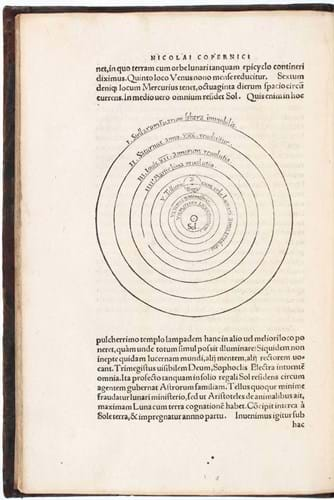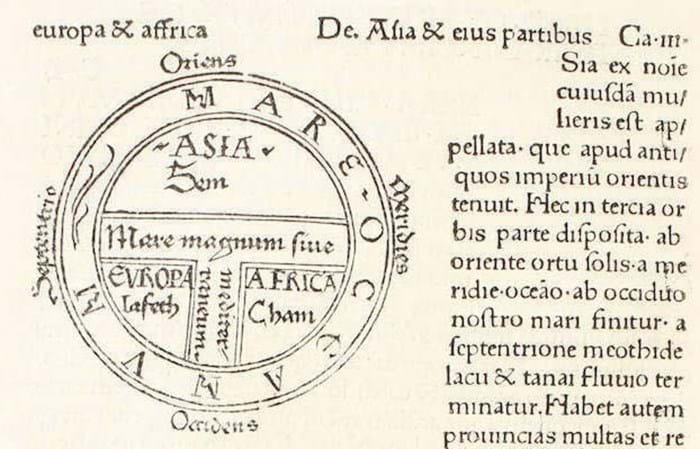
A record sum for a copy of the 1566, expanded second edition of Copernicus’ De revolutionibus orbium coelestium came in the auction marking Reiss & Sohn’s (19% buyer’s premium) 50th year in business.
Printed in Basel, and incorporating for the first time Georg Joachim Rheticus’ Narratio…, or abstract of Copernican heliocentric theories (in third edition form of 1540), this was the star turn in another of the enormous sales that have become a speciality of this German saleroom.
Included in the April 27-30, 3100-lot sale, the example of De revolutionibus showed some dampstaining and a few shortcomings of condition. In a restored but almost contemporary English calf binding, it took €220,000 (£191,305).
On April 8, Swann (25/20/12% buyer’s premium) had offered a copy of the 1566 edition of De revolutionibus… that was browned and stained throughout and described as having seen period marginalia amateurishly and incompletely washed away in several places.
Bound in period style in modern limp parchment, it nevertheless managed a low-estimate $60,000 (£43,795) in New York.
Further highlights
At Reiss, bid to €42,000 (£36,520) was a sammelband, or collection of six works by Johannes Kepler dating from 1614-39. Four of them were wholly focused on mathematical or astronomical matters, while two others dealt with biblical chronology.

Detail from a leaf in the 1472 first of the Etymologie of Isidore of Seville on which appeared the first printed map of the world – €120,000 (£104,350) at Reiss & Sohn.
Another of the highlights, at a five times-estimate €120,000 (£104,350), was a 1472 first of the Etymologie of Isidorus Hispalensis, or Isidore of Seville, a scholar and Archbishop of Seville who died in 636AD.
All manner of subjects are included in the work – mathematics, astronomy, medicine, geography, meteorology, botany, agriculture and much more besides – but its principal claim to fame in this context lies in the small woodcut shown above: the first-ever printed map of the world.
In an example of what have come to be known as T-O maps, the three known continents of the age are shown within a circle, with Asia filling the top half of map and Europe and Africa named below.

One of the many woodcuts of horses, bridles and bits depicted in a work by H Kreutzberger that made €22,000 (£19,130) at Reiss & Sohn. Printed in Augsburg in 1562 and bound in contemporary half calf gilt, this copy features contemporary manuscript captions in German and incorporates some 50 blank leaves, seemingly intended to allow extra notes to be made by the book’s owner.
Sold at €50,000 (£43,480) was a very rare, 1525 first issue Die Zwölf Artikel…, the so-called ‘Twelve…’ or ‘Peasant Articles’. The cataloguer described this work as “…the first draft of human rights and civil liberties in Continental Europe after the Roman Empire”.
Some 25 impressions of the work appeared in that same year, it seems, and a former owner of this first issue example said that it was for a long time to be found displayed in a case in the entrance hall of the British Museum.
It was exhibited alongside another of the museum’s bibliographical treasures, the Greek text Bible of the 4th century AD known as the Codex Sinaiticus.
Saxon Chronicle

Leaf from the Cronecken der Sassen, printed by Peter Schöffer in Mainz in 1492 – €46,000 (£40,000) at Reiss & Sohn.
The front cover of the special, 80-lot selection of major items that made up the first of the three sale catalogues produced by Reiss featured one of 1255 coloured woodcuts (including numerous repeats) found in a copy of the Cronecken der Sassen, or Saxon Chronicle printed by Peter Schöffer in Mainz in 1492. It sold at €46,000 (£40,000).
Captain Cook in German
The very first book form account of Captain Cook’s death in the Hawaiian islands, according to his bibliographer, MK Beddie, appeared not in England but in a rare work published in 1780 in Revela, or Tallinn as the Estonian capital is now known.
Nachrichten von dem Leben den Seereisen des berühmten Captain Cook is based on an unsigned letter – dated Kensington, February 4, 1780 – that incorporates passages from a letter to the Admiralty announcing Cook’s death that had been sent from Kamchatka by Captain Charles Clerke in June of the previous year.
Bound with another work that deals with Spanish voyages to the Pacific Northwest, and which also includes reference to Cook, this rarity sold at €44,000 (£38,260).














